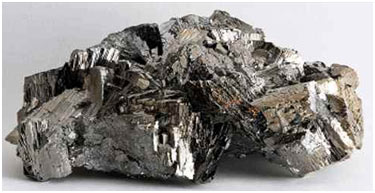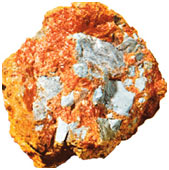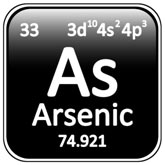Introduction
Arsenic is a semi-metal present in group 15, a member of the nitrogen family. The atomic number of arsenic is 33 and its atomic mass is 74.92. Arsenic has 33 electrons. It has 33 protons and 42 neutrons in its nucleus. Arsenic is represented by the symbol “As”.
- 1) Naming and History
- 2) Occurrence of Arsenic
- 3) Properties of Arsenic
- 4) Allotropes of Arsenic
- 5) Arsenic in Biological Systems
- 6) Uses of Arsenic
- 7) Isotopes of Arsenic
- 8) MCQs
- 9) FAQs – Arsenic: Occurrence, Properties, Allotropes, Uses, and Isotopes of Arsenic
- 10) Summary: Arsenic Tutorial
- 11) You may also like to learn:
Naming and History
The arsenic name has been said to have three origins. The name is from Greek “Arsenikon” a word for yellow pigment orpiment. Or it may derived from Latin “Arsenicum” or the Arabic word “Az Zernikh”.
- Theophrastus
The history of arsenic is dated long ago. In the 4th century BC, the Greek philosopher Theophrastus who was the student of Aristotle knew the compounds of arsenic. These were arsenic sulfide minerals: realgar (As4S4) and orpiment (As2S3).
- Olympiodorus
Ancient Egyptians were aware of arsenic and used it in metal gliding. In the 5th century, Greek historian Olympiodorus obtained white arsenic by roasting arsenic sulfide. The Chinese also knew arsenic and were aware of its toxicity. They used it as pesticides in rice fields.
- Albertus Magnus
German philosopher and theologian Albertus Magnus (1193-1280) was attributed as the discoverer of arsenic. He was the first one who stated that arsenic has metal-like properties. He obtained arsenic by heating arsenic sulfide orpiment with soap.
The highly toxic form of arsenic called white arsenic was obtained as a by-product of copper refining. This was heated with olive oil to obtain arsenic.
Occurrence of Arsenic
Arsenic can be found free but it is very rare. Mostly arsenic is present in minerals such as orpiment, realgar, arsenopyrite, etc. Volcanic activities produce arsenic. Greater amounts of arsenic are by anthropogenic activities such as the burning of fossil fuels.
Properties of Arsenic
Arsenic is classified as metalloid or semi-metal as it possesses characteristics of both metals and non-metals. It occurs in three allotropic forms which are yellow black and grey. Arsenic on heating quickly oxidizes and becomes arsenic trioxide.
It has a garlic-like smell. The nonmetallic form of arsenic is not much reactive but dissolves on heating with strong oxidizing acids and alkalies. The melting point of arsenic is higher than its boiling point, which is 817 °C and its boiling point is 614 °C. It has a density of 5.776 grams per cubic centimeter. Arsenic exists as solid at room temperature.
Allotropes of Arsenic

Grey Arsenic
It is a stable allotropic form that is brittle solid, has a metallic sheen, and is a good conductor of electricity.

Yellow Arsenic
When grey arsenic is cooled in liquid air, yellow arsenic is obtained which is a metastable and a poor conductor of electricity. It converts back to grey arsenic at room temperature.
Black Arsenic
Black arsenic is also brittle, not stable, and as well a poor conductor of electricity. It is obtained by cooling arsenic vapor from 100 °C to 200 °C.
Arsenic in Biological Systems
Researches show that a very small amount of 0.00001% arsenic is required for the proper working of the nervous system in humans.
Some foods like prawns or some vegetables naturally contain arsenic but these are in very, very small doses. The arsenic above 5 mg m-3 is highly toxic and can quickly kill the person. Pure arsenic does not readily absorb into the body so it is less toxic.
White arsenic and other compounds such as AsH3 and As2O3 are highly toxic and carcinogenic. They quickly bound to atoms of hairs inside the body. So, by analyzing hair samples, arsenic exposure can be detected.
Uses of Arsenic
Arsenic is famous for its toxicity. That’s why it is widely used as rat poison, in insecticides and pesticides.
It is an important component of semi-conductor gallium arsenide, which converts electric current into laser light.
Arsenic gas AsH3 is used as a dopant in the microchip industry.
Around two percent of arsenic is added in lead to make alloys for ammunition.
Arsenic is used as a wood preservative.
Germanium transistors use small amounts of arsenic.
It is widely used in manufacturing special types of glass, bronzing, and pyrotechnics.
Isotopes of Arsenic
There are 23 known isotopes of Arsenic. The one stable isotope is As- 75.
MCQs
- What is the atomic number of arsenic?
- A) 32
- B) 33
- C) 34
- D) 35
- Answer: B
- What is the historical origin of the name “arsenic”?
- A) Derived from Latin “Arsenicum”
- B) Originated from Greek “Arsenikon”
- C) Derived from Arabic “Az Zernikh”
- D) All of the above
- Answer: D
- Who is attributed as the discoverer of arsenic and recognized its metal-like properties?
- A) Theophrastus
- B) Olympiodorus
- C) Albertus Magnus
- D) Aristotle
- Answer: C
- How is white arsenic obtained as a by-product of copper refining?
- A) By roasting arsenic sulfide
- B) By heating orpiment with soap
- C) By cooling grey arsenic in liquid air
- D) By burning fossil fuels
- Answer: B
- Where is arsenic primarily found in nature?
- A) Free in large quantities
- B) In minerals such as orpiment and realgar
- C) In volcanic rocks
- D) In fossils
- Answer: B
- What is the classification of arsenic based on its characteristics as a metalloid?
- A) Metal
- B) Non-metal
- C) Metalloid or semi-metal
- D) Transition metal
- Answer: C
- Which allotropic form of arsenic is a good conductor of electricity?
- A) Yellow arsenic
- B) Grey arsenic
- C) Black arsenic
- D) All of them
- Answer: B
- What is the melting point of arsenic?
- A) 614 °C
- B) 817 °C
- C) 500 °C
- D) 700 °C
- Answer: B
- Which allotrope of arsenic is obtained by cooling arsenic vapor from 100 °C to 200 °C?
- A) Grey arsenic
- B) Yellow arsenic
- C) Black arsenic
- D) White arsenic
- Answer: C
- How much arsenic is required for the proper working of the human nervous system?
- A) 0.01%
- B) 0.001%
- C) 0.0001%
- D) 0.00001%
- Answer: D
- Which compound is used for detecting arsenic exposure by analyzing hair samples?
- A) Arsenic trioxide
- B) AsH3
- C) As2O3
- D) White arsenic
- Answer: C
- What is the primary use of arsenic as a wood preservative?
- A) To enhance wood color
- B) To prevent decay
- C) To increase flexibility
- D) To make it fire-resistant
- Answer: B
- In which industry is arsenic gas (AsH3) used as a dopant?
- A) Pharmaceutical
- B) Textile
- C) Semiconductor
- D) Automotive
- Answer: C
- What is the stable isotope of arsenic?
- A) As-32
- B) As-50
- C) As-75
- D) As-100
- Answer: C
FAQs – Arsenic: Occurrence, Properties, Allotropes, Uses, and Isotopes of Arsenic
- Q: What is the atomic number of arsenic?
- A: The atomic number of arsenic is 33.
- Q: What are the three possible origins of the name “arsenic”?
- A: The name may be derived from Greek “Arsenikon,” Latin “Arsenicum,” or the Arabic word “Az Zernikh.”
- Q: Who is credited as the discoverer of arsenic and recognized its metal-like properties?
- A: German philosopher and theologian Albertus Magnus is attributed as the discoverer of arsenic.
- Q: How is white arsenic obtained as a by-product of copper refining?
- A: White arsenic is obtained by heating it with olive oil as a by-product of copper refining.
- Q: Where is arsenic primarily found in nature?
- A: Arsenic is mostly present in minerals such as orpiment, realgar, and arsenopyrite. It can also be found in volcanic activities and as a result of anthropogenic activities like the burning of fossil fuels.
- Q: What are the characteristics of arsenic that classify it as a metalloid or semi-metal?
- A: Arsenic possesses characteristics of both metals and non-metals, classifying it as a metalloid or semi-metal.
- Q: How many allotropic forms does arsenic have, and what are they?
- A: Arsenic has three allotropic forms: grey arsenic, yellow arsenic, and black arsenic.
- Q: What is the primary use of arsenic as a wood preservative?
- A: Arsenic is used as a wood preservative to prevent decay.
- Q: How much arsenic is required for the proper working of the human nervous system?
- A: A very small amount of 0.00001% arsenic is required for the proper working of the nervous system in humans.
- Q: What are the health implications of arsenic exposure above 5 mg m-3?
- A: Arsenic exposure above 5 mg m-3 is highly toxic and can quickly kill a person.
- Q: What are some highly toxic and carcinogenic compounds of arsenic?
- A: White arsenic and other compounds such as AsH3 and As2O3 are highly toxic and carcinogenic.
- Q: How can arsenic exposure be detected in the body?
- A: Arsenic exposure can be detected by analyzing hair samples, as arsenic compounds quickly bind to atoms in hairs.
- Q: What is the significance of arsenic in the semiconductor industry?
- A: Arsenic is an important component of gallium arsenide in the semiconductor industry, converting electric current into laser light.
- Q: What is the stable isotope of arsenic?
- A: The stable isotope of arsenic is As-75.
- Q: How many known isotopes of arsenic are there?
- A: There are 23 known isotopes of arsenic.
- Q: What role does arsenic play in the microchip industry?
- A: Arsenic gas (AsH3) is used as a dopant in the microchip industry.
- Q: Which ancient Greek philosopher knew about the compounds of arsenic in the 4th century BC?
- A: Theophrastus, who was a student of Aristotle, knew about the compounds of arsenic.
- Q: What is the historical origin of the name “arsenic” according to the Greek language?
- A: The name “arsenic” in Greek comes from “Arsenikon,” a word for yellow pigment orpiment.
Summary: Arsenic Tutorial
Introduction: This tutorial takes an in-depth look at arsenic, a semi-metal in group 15 of the nitrogen family, exploring its atomic structure, historical nomenclature, and ancient recognition.
Naming and History: Delving into the historical origins of its name, tracing back to Greek, Latin, and Arabic roots, the narrative unfolds through the eyes of key figures like Theophrastus, Olympiodorus, and Albertus Magnus.
Occurrence of Arsenic: Highlighting the rarity of free arsenic in nature and its prevalence in minerals such as orpiment and realgar, the tutorial sheds light on arsenic’s natural habitat and anthropogenic sources.
Properties of Arsenic: Navigating the metalloid attributes of arsenic, the tutorial explores its three allotropes – grey, yellow, and black arsenic – each possessing distinct characteristics.
Arsenic in Biological Systems: Examining the role of arsenic in minute concentrations for the proper functioning of the nervous system, the tutorial addresses its potential toxicity and methods for exposure detection.
Uses of Arsenic: From its infamous role in rat poison and insecticides to its applications in semiconductor gallium arsenide and various alloys, the diverse and sometimes notorious uses of arsenic are unveiled.
Isotopes of Arsenic: The tutorial concludes with a glimpse into the isotopic landscape of arsenic, unraveling the complexities of its atomic variations and stability.
Conclusion: Whether a student exploring chemistry or a curious mind delving into the world of elements, this tutorial provides a comprehensive understanding of arsenic’s historical significance, natural properties, and contemporary applications.

